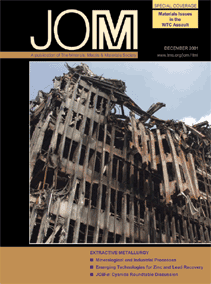An Initial Microstructural Analysis of A36 Steel from WTC Building 7
An Initial Microstructural Analysis of A36 Steel from WTC Building 7
J.R. Barnett, R.R. Biederman, and R.D. Sisson, Jr.| | |
|---|---|
 | OTHER ARTICLES IN THE WTC SERIES "Why Did the World Trade Center Collapse? Science, Engineering, and Speculation" by Thomas Eagar and Christopher Musso Better Materials Can Reduce the Threat from Terrorism by Toni G. Maréchaux An Initial Microstructural Analysis of A36 Steel from WTC Building 7 by J.R. Barnett, R.R. Biederman, and R.D. Sisson, Jr. |
| | |
A section of an A36 wide flange beam retrieved from the collapsed World Trade Center Building 7 was examined to determine changes in the steel microstructure as a result of the terrorist attack on September 11, 2001. This building was not one of the original buildings attacked but it indirectly suffered severe damage and eventually collapsed. While the exact location of this beam could not be determined, the unexpected erosion of the steel found in this beam warranted a study of microstructural changes that occurred in this steel. Examination of other sections in this beam is underway.
ANALYSIS
Rapid deterioration of the steel was a result of heating with oxidation in combination with intergranular melting due to the presence of sulfur. The formation of the eutectic mixture of iron oxide and iron sulfide lowers the temperature at which liquid can form in this steel. This strongly suggests that the temperatures in this region of the steel beam approached ~1,000ºC, forming the eutectic liquid by a process similar to making a “blacksmith’s weld” in a hand forge.
Severely eroded I beam cross sections, nominal composition (%) of A36 steel plate is: (0.29C max, 0.80–1.2Mn, 0.04P, 0.05S, 0.15–0.3Si bal Fe).
Oxidation and intergranular melting; unetched.
Eutectic formation (iron oxide-iron sulfide), etched 4% natal.
An EDX Analysis of eutectic region.
The microstructure of unaffected A36 steel: (a-left) white-ferrite, dark-pearlite and (b-right) pearlite region. Pearlite forms in bands due to manganese segregation and prior hot working.
The authors acknowledge the assistance of Jeremy Bernier and Marco Fontecchio in preparing this information.
J.R. Barnett is a professor of fire protection engineering, and R.R. Biederman and R.D. Sisson, Jr. are professors of materials science and engineering, at Worcester Polytechnic Institute, Worcester, Massachusetts, 01609.





